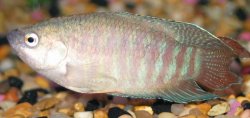ioNightShade
Fish Fanatic
Common name: Paradise Gourami or Paradise Fish
Scientific name: Macropodus opercularis
Family: Anabantidae
Origin: China, Korea, Taiwan, Southern Vietnam, and Japan
Maximum size: 4-5 inches
Minimum Tank size: 20 gallons
Temperature: 58-82�F
Care: The tank should be well-vegetated (for protection/cover and for female retreats). Fish prefer large tank with lots of open swimming area. A partial cover of floating plants is beneficial to aid in bubble nest building. Has been known to jump out of the tank, so should be covered (ideally with a weighted lid). Ideally kept in water with a pH of 7.0. Multiple males, in a tank, have been known to attack each other (sometimes to the point of death).
Feeding: Accepts a variety of tropical flake foods. Also excepts live and frozen foods such as bloodworms, brine shrimp, and planeria. Is also known to eat algae from leaves of plants and rocks.
Sexing: The male is more colorful with longer fins.
Breeding: Take a strong, established pair and place them in a tank alone. Initiate spawning by lowering the water level and increasing the temperature to 75-84�F. Eggs are collected by the male and spit into a bubble nest. Remove the female at this time. There can be up to 1000 eggs in a single spawn and they are guarded by the male. The eggs hatch in 24-28 hours and are free-swimming in 3-5 days. The male should be removed at this time. Feed the fry with infusoria and/or powered dry foods. The fry can later be fed with Artemia (brine shrimp).
Comments: A very hardy fish that can withstand "not-so-ideal" conditions. There are five varieties: red with blue ("original"), red, blue, albino, and black (jet black with red fins)--subspecies concolor.

Scientific name: Macropodus opercularis
Family: Anabantidae
Origin: China, Korea, Taiwan, Southern Vietnam, and Japan
Maximum size: 4-5 inches
Minimum Tank size: 20 gallons
Temperature: 58-82�F
Care: The tank should be well-vegetated (for protection/cover and for female retreats). Fish prefer large tank with lots of open swimming area. A partial cover of floating plants is beneficial to aid in bubble nest building. Has been known to jump out of the tank, so should be covered (ideally with a weighted lid). Ideally kept in water with a pH of 7.0. Multiple males, in a tank, have been known to attack each other (sometimes to the point of death).
Feeding: Accepts a variety of tropical flake foods. Also excepts live and frozen foods such as bloodworms, brine shrimp, and planeria. Is also known to eat algae from leaves of plants and rocks.
Sexing: The male is more colorful with longer fins.
Breeding: Take a strong, established pair and place them in a tank alone. Initiate spawning by lowering the water level and increasing the temperature to 75-84�F. Eggs are collected by the male and spit into a bubble nest. Remove the female at this time. There can be up to 1000 eggs in a single spawn and they are guarded by the male. The eggs hatch in 24-28 hours and are free-swimming in 3-5 days. The male should be removed at this time. Feed the fry with infusoria and/or powered dry foods. The fry can later be fed with Artemia (brine shrimp).
Comments: A very hardy fish that can withstand "not-so-ideal" conditions. There are five varieties: red with blue ("original"), red, blue, albino, and black (jet black with red fins)--subspecies concolor.











